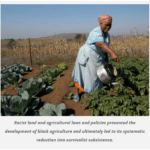by Mazibuko Jara – Oct 2, 2023 Amandla 89,
COLONIALISM, APARTHEID AND neoliberalism remain foundational in shaping the inherited dualistic, unequal and racially divided land and agrarian structure. And we still have that same structure some 29 years into South Africa’s democratic dispensation. At the heart of this structure is the domination of the food system by a few large capitalist farms and other large players in the entire agricultural value chain.
The core features of this inherited land and agrarian structure are a combination of land dispossession, cheap black labour, massive state subsidisation and support of white-controlled, commercialised, and capital-intensive agriculture. Racist land and agricultural laws and policies prevented the development of black agriculture and ultimately led to its systematic reduction into survivalist subsistence.
Going back to the late 1970s, this structure has been impacted by the rise of neoliberal globalisation. There were significant contestations within the ruling class in the pre-1994 period over the direction, content and pace of change in agricultural and economic policy. These contestations saw considerable tensions between conservative protectionist elements in the apartheid regime and modernising segments of agrarian capital. At the heart of these contestations was addressing the profitability crisis of late apartheid. Modernising segments of capital saw a resolution of this crisis through undoing the state-led agricultural system that had been built since the establishment of the Land Bank in 1912 and the passing of the Native Land Act of 1913.
Decisive moments
The 1990-1994 period of negotiations to end formal apartheid, and the first few years of the democratic government, was a decisive moment in laying a new political economy foundation to resolve the profitability crisis. The most significant moment that opened the doorway to resolution was in 1993 when the Transitional Executive Council approved a loan of $850 million from the International Monetary Fund (IMF). Whilst the IMF did not insist on its typical Structural Adjustment Policy conditionalities, it did insist that the TEC and the new democratic government must deliver a statement on economic policy. This would amount to a promise that the incoming government would pursue prudent macroeconomic policies that included a commitment to a future export-oriented economic policy and a “redistribution through growth” strategy.
A second shot was fired when the TEC accepted the industrial tariff reforms proposed in August 1993 by the General Agreement on Trade and Tariffs (GATT – a precursor to the World Trade Organisation). The reforms decimated the clothing and textile sector and also significantly affected the auto sector. In the case of agriculture, the reforms led to a situation where South Africa is one of the leading countries with the least protection for its agriculture. In other words, the new beneficiaries of land reform would have to survive in an agricultural system without the tariff protection that had cushioned white commercial farmers for more than seven decades.
The next moment was the adoption of market-based land reform by the new ANC government. This policy disabled the state from driving a pro-active, expropriation-based redistributive land reform. Instead, the state opted for the willing-buyer, willing-seller principle, and market-determined prices for land, as the core logic of land reform policy.
The final moment was the 1996 passing of the Marketing of Agricultural Products Act. In one sweeping move, this dissolved the entire system of incentives, price controls, regulations and protective measures that had benefitted white commercial agriculture since 1912. This Act effectively deregulated and liberalised agriculture. Similar to the rationalisation of trade tariffs, the Marketing Act removed the cushion of support that land reform beneficiaries would ideally need as new entrants into the agricultural sector.
The Marketing Act also removed any strategic capacity in the state to drive a redistributive agrarian reform. The logic of the Marketing Act was consistent with overall neoliberal macroeconomic policy, as contained in the Growth, Employment and Redistribution strategy released by the ANC government in June 1996.
Constraints of neoliberalism
There is a glaring contradiction. On the one hand the neoliberal deregulation and liberalisation logic of post-apartheid land reform and agricultural policies. On the other, the post-apartheid government’s rhetorical commitment to equity, redistribution and improved livelihoods. Market-based land reform and neoliberal ANC rule reproduce colonial and apartheid underdevelopment.
The neoliberal economic policy choices made by the government in 1996 imposed strict limits on agrarian reform. This denuded land reform of its full potential to transform agrarian space, combat rural poverty, and promote rural development. This means that post-apartheid land reform has failed to drive structural change that would transform investment/capital, land ownership and use, farming systems, markets, the broader value chain and employment.
In sum, post-apartheid land reform and agricultural policies have benefited large commercial farmers and other agribusinesses, instead of existing and aspirant smallholder farmers. These players have used the fact that they produce most of the country’s food, and contribute significantly to export earnings, to pressure policy-makers into believing that there are no other options for agrarian policy. These policies have also weakened the state’s ability to direct public resources towards a transformative agrarian reform agenda. The ANC simply does not trust the mass of ordinary black people with land ownership and food production.

The neoliberal economic policy choices made by the government in 1996 imposed strict limits on agrarian reform. This denuded land reform of its full potential to transform agrarian space, combat rural poverty, and promote rural development.
Broader agrarian crisis
South Africa is a broader agrarian crisis which arises out of four main structural features:
- The continued white ownership of most agricultural land. This means that the majority of the people do not have access to land as a productive asset;
- Biophysical limits which are increasingly exposing the agro-industrial sector as ecologically destructive and expensive;
- The inordinate power of off-farm actors upstream and downstream of commercial farms; and
- Deregulated and liberalised agricultural policy that contradicts even the modest current goals of market-based land reform, and exposes domestic agriculture to the capitalist global agro-food system.
Put differently, the South African agrarian structure limits the possibility for popular food sovereignty based on ecologically sustainable smallholder agriculture (in both rural and urban areas). Therefore, pro-poor land redistribution has to be used in ways that go to the roots of this agrarian crisis, in ways that enable equity, redress, universal food sovereignty, decommodification and ecological sustainability.
This crisis cannot be resolved within the confines of the current economic and agricultural system, as believed by the ANC and government. In his February 2018 State of the Nation Address, President Cyril Ramaphosa simultaneously committed his government to a constitutional amendment to allow for expropriation without compensation, whilst hoping that such an amendment would not destabilise food production and economic growth. Since then, this cautionary approach has been repeated in several ANC media statements and discussion documents.
Hidden behind the apparent rationality of this cautionary approach is the lack of a political will to envision a transformed agrarian structure and food system in South Africa. The ANC remains beholden to agrarian capital in a liberalised and deregulated capitalist economy. The combination of what appears to be a radical measure (to allow expropriation without compensation) with a commitment to a stable agricultural sector is typical of the ANC’s long-held and sustained strategy when it comes to land reform. It is a strategy of “containing contradiction”, combining a commitment to land reform with basic ambivalence about its radical transformative potential.
Another key lesson from the post-apartheid period is that land reform will not succeed unless it is accompanied by parallel policies for rural economic regeneration. For example, land restitution based on legitimate historical claims is very important. However, merely returning people to their land, without providing them with the financial and other forms of support they will need to farm successfully, will not transform rural economies or the agricultural sector in general. Where land redistribution has succeeded in transforming rural economies, other aspects of the agricultural value chain have also been restructured.
The required measures
A 2010 study by the Food and Agriculture Organisation (FAO) of the United Nations has shown that the successful development of modern agriculture, in the era before neoliberalism, was largely based on state support and on controlling the supply and pricing of major agricultural products. Land reform worked in many countries when combined with measures to increase agricultural productivity, stabilise agricultural income, and create non-agricultural jobs. Before the rise of neoliberalism in the 1970s, small and medium-sized farmers in many countries received enough support to allow them to produce most of the food their countries needed.
As already implied above, state support played a vital role in the development of white commercial agriculture in South Africa. State support, albeit in a different form, would again play a key role in creating a context for driving a redistributive land and agrarian reform, with transformative outcomes in land ownership, investment, farming systems, employment and livelihoods.
All of this underlines how land redistribution cannot be separated from a comprehensive programme of agrarian reform. This would encompass land ownership and water resources, infrastructure, financing, input supply, support services, distribution, processing and marketing, as well as other transformative interventions that go beyond the agricultural economy.
New approach needed
We need a new approach, based on a fundamentally different, overarching transformative political economy logic and framework. Such a framework has to depart fundamentally from the neoliberalism that has dominated land reform to date. This will require a move away from the prevalent assumptions in ANC and government policy formulations that capitalist property relations should persist unchallenged, even after widespread land redistribution.

The ANC remains beholden to agrarian capital in a liberalized and deregulated capitalist economy.
The proposed transformative approach must include building new institutional capacities in the state for effective land and agrarian reform. It must also include sectoral interventions in the agricultural value chain, a conducive macroeconomic policy framework, and ensuring sufficient fiscal allocations.
All this will require some significant encroachment into the inordinate power of private capital. This is particularly the case with the rolling back and transformation of the market in land and the associated agricultural value chain.
Further, even this combination of the strategic and the concrete will not be enough to ensure transformative land redistribution. We will also need to break new ground in regenerating the key agency and power of the landless. Transformative power and action from below, so to speak.
So this approach to land redistribution combines these three dynamics: a transformative political economy framework, effective policy solutions and mass power. The approach is framed as the solidarity economy approach applied to land redistribution. This solidarity economy approach centres on what LubabaloNtsholodescribesas being about “the reconstruction of society, about rethinking power and how power is held, by whom and for whom, for what purposes”. This replaces an approach which reduces land redistribution to “a stale process concerned with technicalities around the meaning of legal words, and technical possibilities such words grant to society”.
The key measures required are:
- Radical and fast-tracked land redistribution;
- The promotion of low-risk, low-cost technologies for primary production and some value-adding;
- Increasing state support to agriculture. This would include notably greater support for low-input and small-scale primary production whilst also allowing the endogenous development of a farmer-led solidarity economy funds and resource networks;
- Subsidised production inputs and interest rates for ecologically sustainable agriculture;
- The promotion of and public investment in agricultural co-operatives for supplying, processing and marketing inputs;
- Public investment in ecologically sustainable agricultural technology, irrigation, processing, storage and transport infrastructure, geared to support smallholder production;
- Overcoming monopoly power over product markets, and limiting the exposure of primary producers to risk due to fluctuations in the market prices of inputs and outputs;
- The efficient regulation of skewed agricultural product markets as well as support for the development of alternative markets;
- Altering the agricultural labour regime towards one of self-employment, and labour-intensive and living-wage production where there is waged employment; and
- Opportunities for non-farm economic activities in rural areas, aimed at strengthening diversified livelihood strategies.
These measures are only initial steps towards a long path of transforming agriculture away from domination by large-scale industrial agriculture and towards a situation in which conditions for food sovereignty, from household to national level, may be possible and irreversible.
But these measures will not come from above. They require significant encroachments challenging the state and capital. Land occupation and the promotion of alternative production systems from below are key. The Cape Town Covid-19 land occupations and the nascent agroecology movement are showing us the way.
In Cape Town and beyond, the Covid-19 occupations saw relatively bigger plots than before, in order to accommodate a shack as well as land for a small food garden and for chickens and pigs. In addition to these larger individual plots, in some of the occupations, there is also an allocation of common land for bigger collective production of food, chicken and pigs.”
And the agroecology movement has connected a growing network of organic small farmers who use low-cost methods and are building seed banks and alternative markets.
Mazibuko Jara is a Marxist, small-scale farmer activist, trainer and popular educator based in Keiskammahoek. He is the Executive Director of the Zabalaza Pathways Institute.
Republished From: https://www.amandla.org.za/going-beyond-failed-land-and-agrarian-reform/?fbclid=IwAR3UBAdWgY4bScRXtfuwINHDbsCItUHX6BwNGpOwNR2sciNGX3Vzz1kxiU8
![]()




